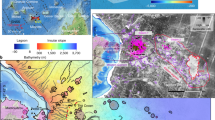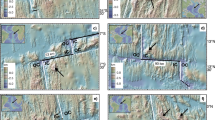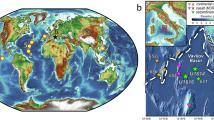Abstract
The internal ocean of Jupiter’s moon Europa is thought to be a prime candidate for hosting extraterrestrial life. Europa’s silicate interior may contribute to habitability through the generation of reactants from hydrothermal activity, serpentinization or other geological processes occurring on or just below Europa’s sea floor. However, silicates are thought to melt at depths >100 km in Europa’s mantle, and it is unknown whether this magma can penetrate and travel through the moon’s probably thick, brittle lithosphere to erupt at the sea floor. We combine previous approaches for modelling melt generation in the Europan interior and lithospheric dyke transport to show that Europan sea-floor volcanism is strongly inhibited by its lithosphere. The low stress state of the Europan interior hinders the ability of dykes to penetrate through the lithosphere. Should dykes form, they penetrate <5% of the 200–250-km-thick lithosphere. Low mantle melt fractions (3–5%) drive a sluggish pore-space magma flow, leading to dyke influxes 10,000 times lower than that necessary for sea-floor eruption. These results strongly indicate that models of Europan habitability reliant on present-day volcanism at its sea floor are implausible.
This is a preview of subscription content, access via your institution
Access options
Access Nature and 54 other Nature Portfolio journals
Get Nature+, our best-value online-access subscription
$32.99 / 30 days
cancel any time
Subscribe to this journal
Receive 12 digital issues and online access to articles
$119.00 per year
only $9.92 per issue
Buy this article
- Purchase on SpringerLink
- Instant access to full article PDF
Prices may be subject to local taxes which are calculated during checkout




Similar content being viewed by others
Data availability
All data used to generate the results presented in this work and their associated input parameter files are available via Zenodo at https://doi.org/10.5281/zenodo.10850608 (ref. 55).
Code availability
The convection code StagYY is the property of P.J.T. and Eidgenössische Technische Hochschule (ETH) Zürich. Researchers interested in using StagYY should contact P.J.T. (paul.tackley@erdw.ethz.ch).
References
Hand K. P. et al. In Europa (eds Pappalardo, R. T. et al.) 589–629 (Univ. of Arizona Press, 2009).
Vance, S. D. et al. Investigating Europa’s habitability with the Europa Clipper. Space Sci. Rev. 219, 81 (2023).
Khurana, K. K. et al. Induced magnetic fields as evidence for subsurface oceans in Europa and Callisto. Nature 395, 777–780 (1998).
Howell, S. M. The likely thickness of Europa’s icy shell. Planet. Sci. J. 2, 129 (2021).
Gaidos, E. J., Nealson, K. H. & Kirschvink, J. L. Life in ice-covered oceans. Science 284, 1631–1633 (1999).
Chyba, C. F. & Hand, K. P. Life without photosynthesis. Science 292, 2026–2027 (2001).
McCollom, T. M. Methanogenesis as a potential source of chemical energy for primary biomass production by autotrophic organisms in hydrothermal systems on Europa. J. Geophys. Res.: Planets 104, 30729–30742 (1999).
Vance, S. D., Hand, K. P. & Pappalardo, R. T. Geophysical controls of chemical disequilibria in Europa. Geophys. Res. Lett. 43, 4871–4879 (2016).
Běhounková, M. et al. Tidally induced magmatic pulses on the oceanic floor of Jupiter’s moon Europa. Geophys. Res. Lett. 48, e2020GL090077 (2021).
Trinh, K. T., Bierson, C. J. & O’Rourke, J. G. Slow evolution of Europa’s interior: metamorphic ocean origin, delayed metallic core formation, and limited seafloor volcanism. Sci. Adv. 9, eadf3955 (2023).
Bland, M. T. & Elder, C. M. Silicate volcanism on Europa’s seafloor and implications for habitability. Geophys. Res. Lett. 49, e2021GL096939 (2022).
Kattenhorn, S. A. & Prockter, L. M. Evidence for subduction in the ice shell of Europa. Nat. Geosci. 7, 762–767 (2014).
Collins, G. C. et al. Episodic plate tectonics on Europa: evidence for widespread patches of mobile‐lid behavior in the antijovian hemisphere. J. Geophys. Res.: Planets 127, e2022JE007492 (2022).
Greenberg, R. Transport rates of radiolytic substances into Europa’s ocean: implications for the potential origin and maintenance of life. Astrobiology 10, 275–283 (2010).
Green, A. P., Montesi, L. G. J. & Cooper, C. M. The growth of Europa’s icy shell: convection and crystallization. J. Geophys. Res.: Planets 126, e2020JE006677 (2021).
Hand, K. P., Sotin, C., Hayes, A. & Coustenis, A. On the habitability and future exploration of ocean worlds. Space Sci. Rev. 216, 95 (2020).
Moore, W. B. et al. In Europa (eds Pappalardo, R. T. et al.) 369–380 (Univ. of Arizona Press, 2009).
Lowell, R. P. & DuBose, M. Hydrothermal systems on Europa. Geophys. Res. Lett. https://doi.org/10.1029/2005GL022375 (2005).
Moresi, L. & Solomatov, V. Mantle convection with a brittle lithosphere: thoughts on the global tectonic styles of the Earth and Venus. Geophys. J. Int. 133, 669–682 (1998).
Weller, M. B. & Lenardic, A. On the evolution of terrestrial planets: bi-stability, stochastic effects, and the non-uniqueness of tectonic states. Geosci. Front. 9, 91–102 (2018).
Rivalta, E., Taisne, B., Bunger, A. P. & Katz, R. F. A review of mechanical models of dyke propagation: schools of thought, results and future directions. Tectonophysics 638, 1–42 (2015).
Kühn, D. & Dahm, T. Numerical modelling of dyke interaction and its influence on oceanic crust formation. Tectonophysics 447, 53–65 (2008).
Lister, J. R. Steady solutions for feeder dykes in a density-stratified lithosphere. Earth Planet. Sci. Lett. 107, 233–242 (1991).
Roper, S. M. & Lister, J. R. Buoyancy-driven crack propagation: the limit of large fracture toughness. J. Fluid Mech. 580, 359–380 (2007).
Tackley, P. J. Modelling compressible mantle convection with larges viscosity contrasts in a three-dimensional spherical shell using the yin-yang grid. Phys. Earth Planet. Inter. 171, 7–18 (2008).
Lister, J. R. & Kerr, R. C. Fluid‐mechanical models of crack propagation and their application to magma transport in dykes. J. Geophys. Res.: Solid Earth 96, 10049–10077 (1991).
Rubin, A. M. Propagation of magma-filled cracks. Annu. Rev. Earth Planet. Sci. 23, 287–336 (1995).
Atkinson, B. K. Subcritical crack growth in geological materials. J. Geophys. Res.: Solid Earth 89, 4077–4114 (1984).
Balme, M. R. et al. Fracture toughness measurements on igneous rocks using a high-pressure, high-temperature rock fracture mechanics cell. J. Volcanol. Geotherm. Res. 132, 159–172 (2004).
Delaney, P. T. & Pollard, D. D. Deformation of Host Rocks and Flow of Magma during Growth of Minette Dykes and Breccia-bearing Intrusions near Ship Rock, New Mexico Professional Paper No. 1202 (USGS, 1981).
Scholz, C. H. A note on the scaling relations for opening mode fractures in rock. J. Struct. Geol. 32, 1485–1487 (2010).
Gudmundsson, A. Magma chambers: formation, local stresses, excess pressures, and compartments. J. Volcanol. Geotherm. Res. 237, 19–41 (2012).
Erarslan, N. & Williams, D. J. Investigating the effect of cyclic loading on the indirect tensile strength of rocks. Rock Mech. Rock Eng. 45, 327–340 (2012).
Byrne, P. K. et al. Likely little to no geological activity on the Europan seafloor. In Proc. 55th Lunar and Planetary Science Conference https://www.hou.usra.edu/meetings/lpsc2024/pdf/2780.pdf (Lunar and Planetary Institute, 2024).
Hussmann, H. et al. Implications of rotation, orbital states, energy sources, and heat transport for internal processes in icy satellites. Space Sci. Rev. 153, 317–348 (2010).
Chevrel, M. O., Pinkerton, H. & Harris, A. J. Measuring the viscosity of lava in the field: a review. Earth-Sci. Rev. 196, 102852 (2019).
Sundberg, M., Hirth, G. & Kelemen, P. B. Trapped melt in the Josephine peridotite: implications for permeability and melt extraction in the upper mantle. J. Petrol. 51, 185–200 (2010).
Thordarson, T. & Self, S. Atmospheric and environmental effects of the 1783–1784 Laki eruption: a review and reassessment. J. Geophys. Res.: Atmos. 108, AAC-7 (2003).
Huppert, H. E. & Sparks, R. S. J. Komatiites I: eruption and flow. J. Petrol. 26, 694–725 (1985).
Williams, D. A., Wilson, A. H. & Greeley, R. A komatiite analog to potential ultramafic materials on Io. J. Geophys. Res.: Planets 105, 1671–1684 (2000).
Williams, D. A., Schenk, P. M. & Radebaugh, J. In Io: A New View of Jupiter’s Moon (eds Lopes, R. M. C. et al.) 147–172 (Springer, 2023).
Tobie, G., Choblet, G. & Sotin, C. Tidally heated convection: constraints on Europa’s ice shell thickness. J. Geophys. Res. 108, 5124 (2003).
Hiesinger, H. et al. Ages and stratigraphy of lunar mare basalts: a synthesis. In Recent Advances and Current Research Issues in Lunar Stratigraphy (eds Ambrose, W. A. & Williams, D. A.) Ch. 1 (Geological Society of America, 2011).
Ivanov, M. A. & Head, J. W. The history of volcanism on Venus. Planet. Space Sci. 84, 66–92 (2013).
Broquet, A. & Andrews-Hanna, J. C. Geophysical evidence for an active mantle plume underneath Elysium Planitia on Mars. Nat. Astron. 7, 160–169 (2023).
Khan, A. et al. Evidence for a liquid silicate layer atop the Martian core. Nature 622, 718–723 (2023).
Hernlund, J. W. & Tackley, P. J. Modeling mantle convection in the spherical annulus. Phys. Earth Planet. Inter. 171, 48–54 (2008).
Karato, S. Deformation of Earth Materials: An Introduction to the Rheology of the Solid Earth (Cambridge Univ. Press, 2008).
Hirth, G. & Kohlstedt, D. In Inside the Subduction Factory. American Geophysical Union, Geophysical Monograph 138 (ed Eiler, J.) 83–106 (American Geophysical Union, 2003).
Hernlund, J. W., Tackley, P. J. & Stevenson, D. J. Buoyant melting instabilities beneath extending lithosphere. I. Numerical models. J. Geophys. Res. https://doi.org/10.1029/2006JB004862 (2008).
Herzberg, C., Raterron, P. & Zhang, J. New experimental observations on the anhydrous solidus for peridotite KLB‐1. Geochem. Geophys. Geosystems https://doi.org/10.1029/2000GC000089 (2000).
Hussman, H. & Spohn, T. Thermal-orbital evolution of Io and Europa. Icarus 171, 391–410 (2004).
Ojakangas, G. W. & Stevenson, D. J. Thermal state of an ice shell on Europa. Icarus 81, 220–241 (1989).
Bierson, C. J. The impact of rheology model choices on tidal heating studies. Icarus 414, 116026 (2024).
Green, A. Repository: no magmatic driving force for Europan seafloor volcanism. Zenodo https://doi.org/10.5281/zenodo.10850608 (2024).
Acknowledgements
The research was carried out at the Jet Propulsion Laboratory, California Institute of Technology, under a contract with the National Aeronautics and Space Administration (Grant No. 80NM0018D0004; recipients A.P.G., M.T.B. and C.M.E.). Any use of trade, firm or product names is for descriptive purposes only and does not imply endorsement by the US Government. © 2024. All rights reserved.
Author information
Authors and Affiliations
Contributions
A.P.G. led the project; conceptualized, designed and implemented all new additions to StagYY; constructed the Europa interior model; generated all results and wrote the text. C.M.E. and M.T.B. conceptualized the research direction and acquired funding. C.M.E. directly supervised the research and writing process and provided substantial draft revisions. M.T.B. advised on dyke propagation and the acquisition of results and provided substantial draft revisions. P.J.T. advised on model development in StagYY and provided draft revisions. P.K.B. provided substantial draft revisions.
Corresponding author
Ethics declarations
Competing interests
The authors declare no competing interests.
Peer review
Peer review information
Nature Astronomy thanks Joseph O’Rourke and the other, anonymous, reviewer(s) for their contribution to the peer review of this work.
Additional information
Publisher’s note Springer Nature remains neutral with regard to jurisdictional claims in published maps and institutional affiliations.
Supplementary information
Supplementary Information
Supplementary Discussion 1–4, Figs. 1–8 and Tables 1–3.
Rights and permissions
Springer Nature or its licensor (e.g. a society or other partner) holds exclusive rights to this article under a publishing agreement with the author(s) or other rightsholder(s); author self-archiving of the accepted manuscript version of this article is solely governed by the terms of such publishing agreement and applicable law.
About this article
Cite this article
Green, A.P., Elder, C.M., Bland, M.T. et al. No magmatic driving force for Europan sea-floor volcanism. Nat Astron 9, 640–649 (2025). https://doi.org/10.1038/s41550-025-02508-8
Received:
Accepted:
Published:
Issue date:
DOI: https://doi.org/10.1038/s41550-025-02508-8
This article is cited by
-
Europa’s silent seafloor
Nature Astronomy (2025)



